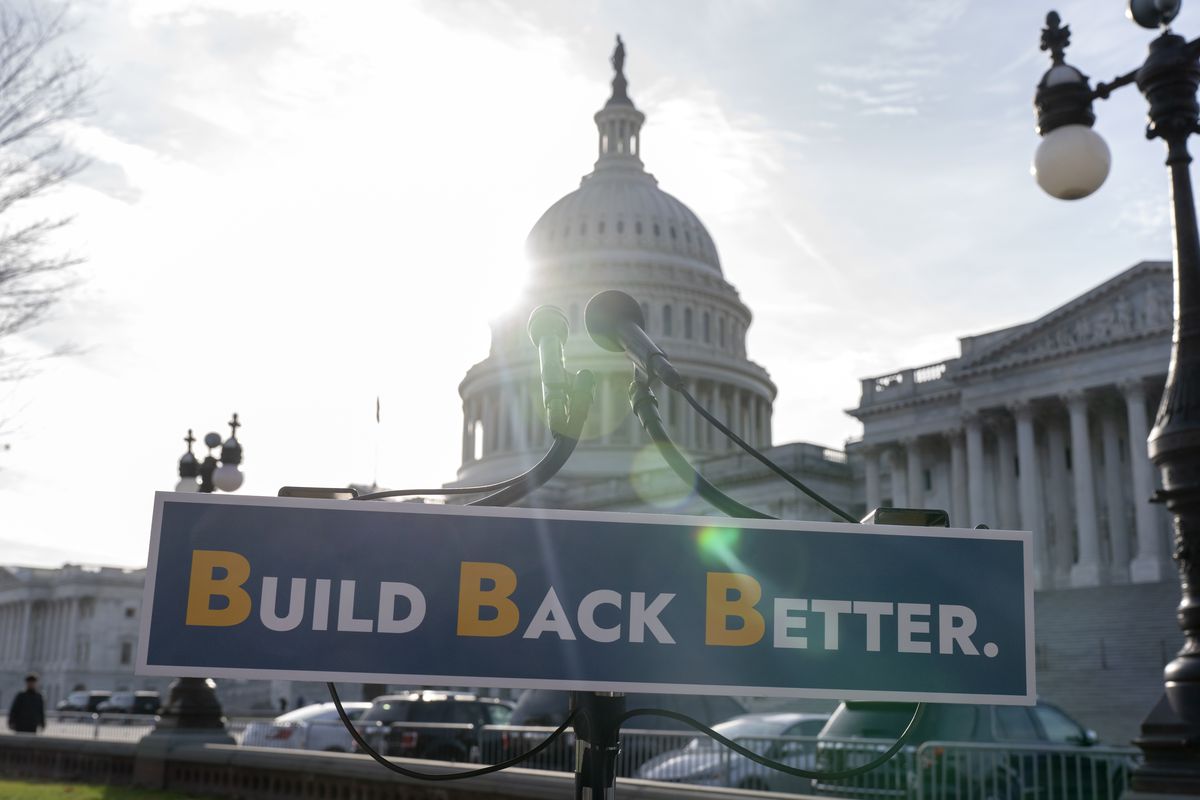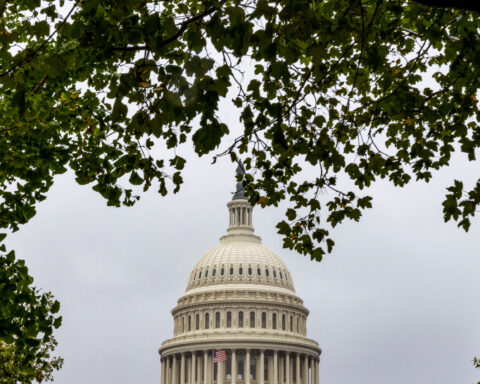No more monthly payments for tens of millions of families. No universal pre-kindergarten for 3- and 4-year-olds. No health insurance for more than 2 million low-income Americans. No funneling of billions of dollars into clean energy initiatives.
The end of negotiations between President Joe Biden and Democratic Sen. Joe Manchin of West Virginia means that these and a multitude of other provisions to strengthen the nation’s safety net won’t happen — at least not soon.
The fate of the Democrats’ $1.75 trillion spending plan is now uncertain. Manchin announced on Sunday that he would not support the current version of the legislation, halting its path through the Senate since the party needs the support of all 50 of its members to approve the package through the budget reconciliation process. It passed the House last month.
Manchin has repeatedly voiced concerns about the size of the proposal, which he called a “mammoth piece of legislation” on Sunday. He has objected to the enhanced child tax credit, paid family leave and climate provisions, along with several tax measures. Plus, he said the package could add to the nation’s rising debt and worsen inflation, which is already soaring.
A majority of the legislation would be paid for with new tax increases on corporations and the wealthy. But even with those revenue raisers, the Congressional Budget Office estimated it would add $367 billion to the deficit over 10 years.
Senate Majority Leader Chuck Schumer on Monday vowed that the chamber would “vote on a revised version of the House-passed Build Back Better and we will keep voting on it until we get something done.”
What that package ultimately looks like remains to be seen.
Here are the proposed safety net programs that are now at risk of being dropped:
Enhanced child tax credit: The current version of Build Back Better would have continued the enhanced child tax credit monthly payments through 2022.
Instead, the December installment of up to $300 per child that was sent to more than 36 million families may be the last one. The boost, part of the American Rescue Plan that Biden signed in March, is only in effect for 2021.
This expensive provision has been one of Manchin’s main concerns. Extending the beefed-up credit for a year — and making it fully refundable permanently — would cost about $185 billion, according to CBO.
But Manchin is concerned that the enhanced payments would be extended again because they’d be too popular to ax. Making the provision permanent would cost $1.6 trillion over 10 years, CBO estimated.
Eligible parents have received up to $300 for each child up to age 6 and $250 for each one ages 6 through 17 on a monthly basis since July, which accounts for half of the enhanced credit. Families will receive the other half when they submit their 2021 tax return next season.
In total, the expanded credit provides up to $3,600 for each younger child and up to $3,000 for each older one.
Also, more low-income parents became eligible for the full credit because the American Rescue Plan made it fully refundable for a year. It had been only partially refundable — leaving more than 26 million children unable to get the entire credit because their families’ incomes were too low, according to Treasury Department estimates.
The enhancement has been key to the Democrats’ promise to reduce child poverty. The November payment kept 3.8 million kids from poverty and slashed the child poverty rate by nearly 30%, according to the Center on Poverty and Social Policy at Columbia University.
Medicaid coverage gap: Build Back Better’s current version would have provided a pathway to health insurance for more than 2 million low-income Americans in the 12 states that have not expanded Medicaid. It would have enabled them to receive Affordable Care Act subsidies to buy Obamacare policies with no monthly premiums through 2025.
Doing so would have cost about $57 billion, the CBO estimates.
And the bill would have required state Medicaid programs to provide 12 months of eligibility to women after they give birth. States now typically provide 60 days of coverage.
Child care: The legislation would have limited child care costs for families with children younger than age 6 to no more than 7% of income for those earning up to 250% of state median income, expanding access to about 20 million children. Funding would have lasted six years. The provision, along with the universal pre-K measure, would have cost an estimated $381 billion, according to CBO.
Universal pre-K: The bill would have provided free pre-K for 3- and 4-year-olds, expanding access to 6 million children a year. Funding would have lasted six years. The provision, along with the child care measure, would have cost an estimated $381.5 billion, according to the CBO.
Affordable Care Act subsidies: Americans may only receive enhanced Obamacare federal premium subsidies for another year if Build Back Better is never enacted.
The boost, which is prompting record numbers of Americans to sign up for coverage on the exchanges, is currently scheduled to end after 2022. The Democrats’ spending plan would have extended it through 2025 at a cost of $74 billion, according to CBO.
The number of uninsured Americans would have dropped by 3.4 million, mainly due to the subsidies extension and the Medicaid provision, CBO estimates.
The legislation also would have added a year to the American Rescue Plan provision that allows those receiving unemployment benefits to qualify for federal subsidies that reduce their monthly premiums to as little as $0. It was only in effect for 2021.
Medicare hearing benefits: Senior citizens and Americans with disabilities would have received hearing coverage through Medicare, starting in 2023, under the current version of Build Back Better.
Only 30% of seniors over age 70 who could benefit from hearing aids have ever used them, the White House said. This measure would have cost $36.7 billion, according to CBO.
Children’s nutrition: The current bill would have expanded free school meals to nearly 9 million children during the school year and provided the parents of 29 million kids a $65 per child per month benefit to purchase food during the summer.
Earned income tax credit: The expanded earned income tax credit would have been extended through 2022, helping 17 million low-wage childless workers, under the current version of Build Back Better.
The boost, which is also part of the American Rescue Plan, is only in place for this year. It nearly triples the maximum credit childless workers can receive, extends eligibility to more people, reduces the minimum age and eliminates the upper age limit. This provision costs about $13 billion, according to CBO.
Home health care: Build Back Better called for permanently improving Medicaid coverage for home care services for seniors and people with disabilities, with the goal of reducing the more than 800,000 people on state Medicaid waiting lists.
It also aimed to improve the quality of caregiving jobs. The measure would have cost nearly $146 billion, according to CBO.
Drug price reduction efforts: Build Back Better contained multiple efforts to lower the price of prescription medication — most notably allowing Medicare to negotiate prices for the first time.
The bill would have empowered Medicare to negotiate prices of certain costly medications administered in doctors’ offices or purchased at the pharmacy. The Health and Human Services secretary would negotiate up to 10 drugs in 2025 and up to 20 medications starting in 2028.
The legislation also would have imposed penalties if drug companies increased their prices faster than inflation. And it would have redesigned Medicare’s Part D drug plans so that seniors and people with disabilities wouldn’t have had to pay more than $2,000 for medications bought at the pharmacy.
The bill would also have capped what Americans pay for insulin at $35 a month.
And it would blocked the implementation of a Trump administration regulation that would change the drug industry’s rebate system, though it isn’t set to go into effect until 2026. The rule effectively bans drug makers from providing rebates to pharmacy benefit managers and insurers. Instead, drug companies are encouraged to pass the discounts directly to patients at the pharmacy counter.
Altogether, these measures would have saved around $297 billion, including about $79 billion from allowing Medicare to negotiate drug prices, according to CBO.
Paid family and sick leave: The bill would have provided four weeks of paid leave for new parents as well as workers recovering from illness or caring for sick family members. It would have cost an estimated $205.5 billion, according to the CBO.
The United States currently has no federal paid family or sick leave benefit, making it an outlier among developed countries.
Pell grants: Build Back Better would have increased the maximum Pell grant by $550 for more than 5 million students enrolled in public and private nonprofit colleges and expand access to undocumented students brought to the US as children, who are known as Dreamers.
It would have invested in historically Black colleges and universities and other institutions that serve underrepresented communities, as well as increased funding for workforce development.
These provisions would have cost a total of $39.8 billion, according to the CBO’s estimate.
Affordable housing: The legislation called for a $25 billion investment in the construction, rehabilitation or purchase of affordable homes for low-income people and for the creation and preservation of affordable rental housing. It would have provided $65 billion to address the capital needs backlog of public housing and would bolster rental assistance to hundreds of thousands of families.
The measure would have also invested in down payment assistance and in community-led redevelopment projects in under-resourced neighborhoods. And it would have provided $24 billion to fund housing vouchers and supportive services.
The effort would have cost about $148.1 billion, according to the CBO.
Tax credits for fighting climate change: The bill would have delivered nearly $570 billion in tax credits and investments aimed at combating climate change. It would have offered tax credits to families that install solar rooftops or buy electric vehicles, for example. Taxpayers would have been allowed to claim a tax credit worth up to $900 for purchasing an e-bike before 2026.


